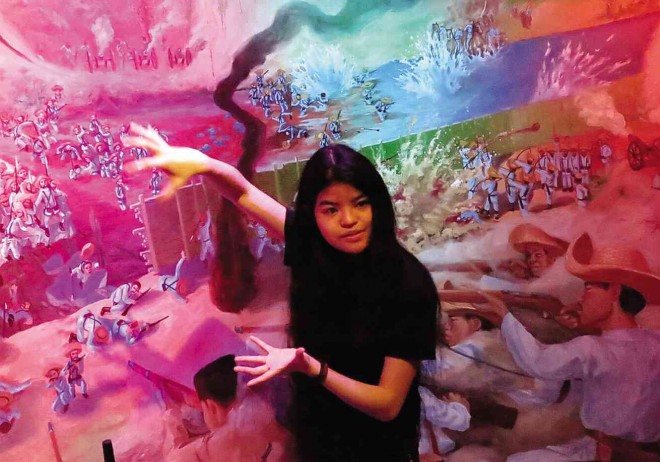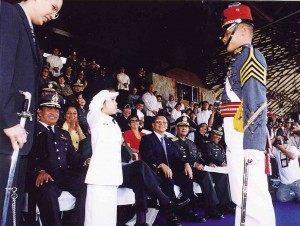‘Girl general’ faces most important task: Defending Aguinaldo

NOW 17, Emiliana Ricanette “Milly” Suntay Tañedo has become the best tour guide of the family-run Emilio Aguinaldo Museum in Baguio City. EV ESPIRITU
At the pregraduation ceremony for the Philippine Military Academy (PMA) Banyuhay Class in 2002, all eyes were focused on 6-year-old Milly Tañedo, who stood at attention wearing a replica of the late Gen. Emilio Aguinaldo’s white military uniform at Fajardo Grandstand in Fort del Pilar, Baguio City.
Milly, Aguinaldo’s great great granddaughter, handed the Aguinaldo Saber to Cadet First Class Nilo Siddayao who ranked highest in the class for leadership, conduct and aptitude. Then to the cadet’s surprise, the “girl general” gave him a salute.
Everyone on the stage, including then Defense Secretary Angelo Reyes, chortled in amusement at Milly’s spunk and Siddayao’s discomfort.
Born Emiliana Ricanette Suntay Tañedo, Milly is now 17, and she continues the task she inherited from her uncle, Emilio Aguinaldo Suntay III.
On June 12, Independence Day, she took on a different task, serving as an eloquent and well-read tour guide at the family’s Emilio Aguinaldo Museum in Baguio, home to the Philippine flag that was raised during the Philippine Independence proclamation on June 12, 1898, in Kawit town, Cavite province.
Article continues after this advertisementMilly said mastering the family story and how the Aguinaldo name helped shape the country was also a job for which she was trained by the family of the country’s first President.
Article continues after this advertisementDistorted image
Milly spent her growing years flying to the Philippines for her annual PMA duty from Sydney, Australia, where her family is based. Those were trying years for a child who occasionally watched adults speak ill of Aguinaldo, she said.
“Being so close to your history can bring you closer to a lot of unpleasantries,” Milly said. These include “the way people often view my great great grandfather, his image having been skewed and distorted throughout time. While I never met him, I met the people who knew him best—as the quiet and humble man he was,” she said.
History credits Aguinaldo for declaring Philippine Independence and assembling the first Philippine Republic, but unresolved issues about his role in the death of Katipunan founder Andres Bonifacio and how he handled the Philippine-American war gave some critics ammunition to define the hero as a Machiavellian villain.
“The Internet makes it easier for people to voice their hate for him. And it’s surprising. They harbor a lot of hate for him,” Milly said. She blamed the American colonial government for the “historical brainwashing” in retaliation against the rebellion Aguinaldo led.
“And our people, fragmented as they were, took it the wrong way. This happened in 1901 and more than a hundred years later, it still continued to disillusion many of us,” she said.
Milly said this fact convinced her that defending her great great grandfather has become her third—and most important—family task.
Suntay, her uncle who presented the first Aguinaldo Saber in 1976, had been a vocal advocate for peace among the heirs of Filipino heroes.
He said: “For too long, our society has required our heroes to be perfect, flawless. We have overlooked the fact that they are humans like us, not gods. We at Aguinaldo Museum have always highlighted that while [Dr. Jose] Rizal can be slow to act; [Andres] Bonifacio, temperamental; [Gen. Antonio] Luna, ruthless and ambitious; [Gen. Gregorio] del Pilar, a hopeless romantic; Aguinaldo naive and too deferring … they were nonetheless great men and heroes, in their own right and to their race.”
“Despite their human frailties and flaws, our forefathers rose and sacrificed their lives for their country,” Suntay said. “Thus is the essence of heroism.”
Milly said many of the heroes were judged by people who forgot that they were fighting wars: the Philippine Revolution and the Philippine-American war.
Setting record straight
“I mean, to this day, people still speak ill of him on comment threads and on the Internet. We try to keep it to ourselves normally, but we are bothered because we feel like we have a moral obligation to preserve his legacy and to present the truth,” she said.
Milly has been helping her uncle handle museum tours “to be able to set the record straight, [by] presenting to people their history truthfully and genuinely, without any hidden political or vengeful agenda.”
“I’m only 17. I don’t have very many political whims to fulfill,” she said. “My mom (Nenita Aguinaldo Suntay, who is Suntay’s sister) was very adamant [about] raising me in the best way she could. She wanted me to be aware of not just my history but what was going on in our country and in the world as well,” she said.
The family-run museum in Baguio offered her a chance to dig through her great great grandfather’s letters and essays.
“It’s all so fascinating. I grew up loving movies like [the 1980s adventure film] ‘The Goonies’ so it feels like you’re going through treasure when you look through his old things,” Milly said.
